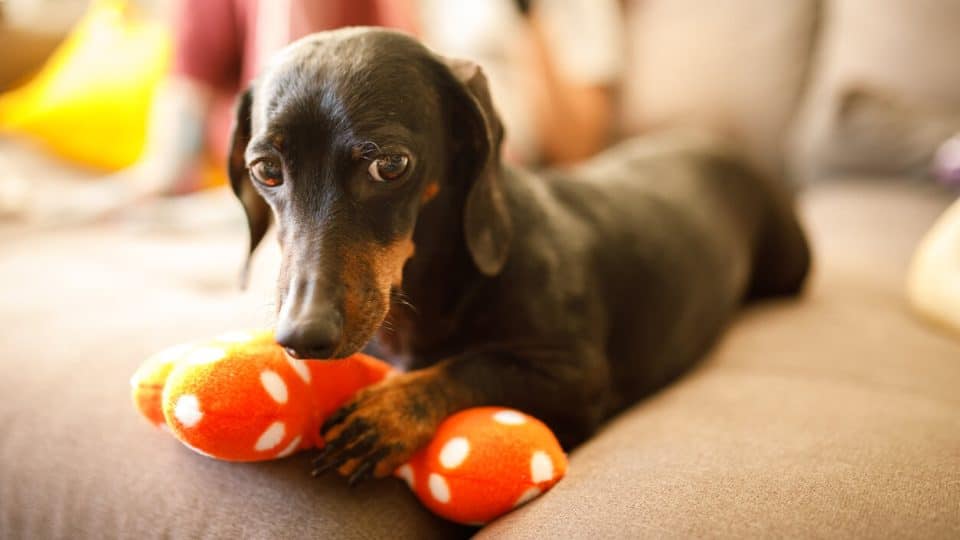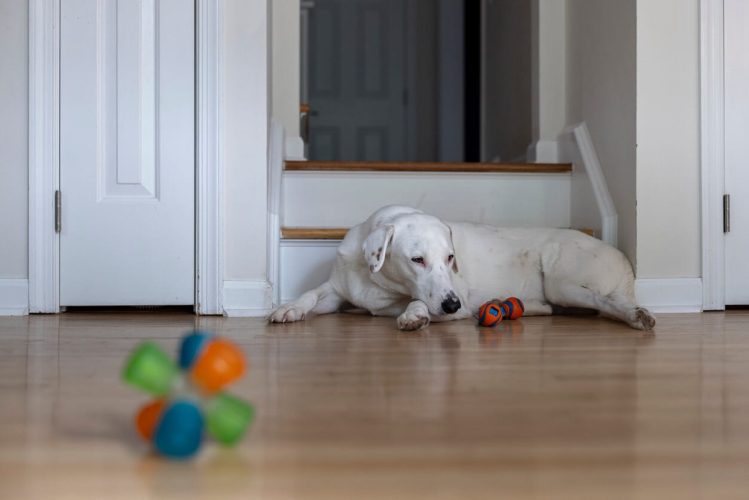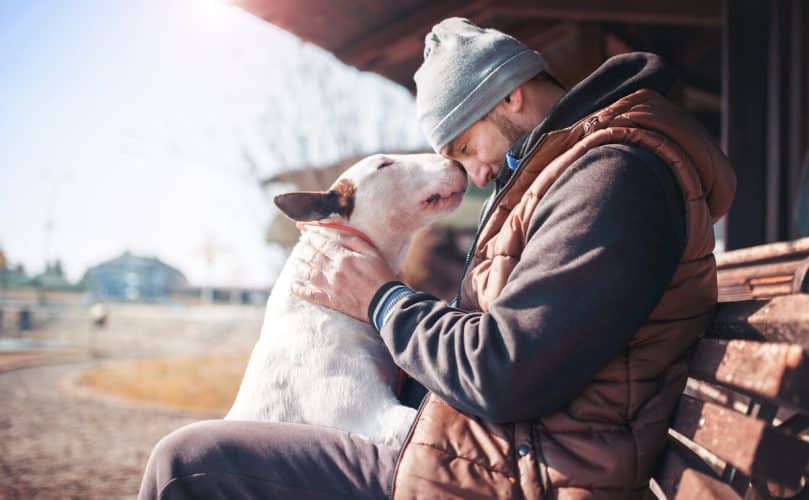Your dog is part of your family, absolutely. Even so, that doesn’t necessarily mean they want to share with you—something you may already know if your dog has a habit of resource guarding.
Resource guarding is a natural and fairly common dog behaviour. Some dogs simply have more of an instinctive desire to guard things, while other dogs may have also learned this behaviour through negative experiences, like not getting enough food.
Though resource guarding isn’t always a problem, it can sometimes pose a risk to your safety. If your dog finds something they shouldn’t eat, explains Steffi Trott, owner and founder of SpiritDog Training, you need to know you can take it away from them right away without worrying they may snap or bite you.
If your dog does guard their food, treats, and treasured toys, don’t despair! You can address this behaviour with patience and positive reinforcement. Read on to learn the early signs of resource guarding, where this behaviour comes from, and how to handle it.
Signs Your Dog Is Resource Guarding
You can often recognise signs of resource guarding in your dog’s body language and behaviour.
When someone approaches your dog’s resource or treasured item, they may:
- lean over the resource
- tense up or freeze (their body may suddenly stiffen, while their eyes stare into the middle distance)
- eat faster, if guarding their food
- watch you from the corner of their eye, showing the white of their eye (this is called ‘whale eye’)
- grab the item and turn away, move to a new spot, or hide behind or under something
- snarl, growl, or show their teeth
- bark
- lunge
- snap at the air
- bite
Not sure if your dog is truly resource guarding or playing a game like keep-away? Trott recommends observing their general body language for clues.
“Games of keep-away will usually involve loose body language and our dogs acting ‘goofy’,” she says. For instance, they may get the zoomies before stopping to let you catch them, play bowing, and then run away again.
On the other hand, a dog possessively guarding a specific resource will likely have very stiff, tense posture. They won’t stick around to play with you. Instead, they’ll hide or find a safe space where they can settle down with their prize.
Why Do Dogs Guard Resources?
So why do dogs even guard stuff in the first place? After all, most of them have more than enough toys and food!
“No behaviour exists without a reason,” says Rachel Salant, animal behaviour specialist at Veterinarians.org. She adds that resource guarding likely began as a way for your dog’s distant canine relatives to maintain possession of limited resources.
But every dog is an individual, and the reason why they choose to guard their resources—and the extent of their behaviour—is unique to them.
According to Salant, some common reasons may relate to your dog’s history. For instance, maybe they:
- grew up as a stray with limited access to food
- grew up in an environment where they had to compete with many dogs for a bed
- have had resource guarding behaviour reinforced in the past
dogs of any breed and age can show resource-guarding tendencies, but you may notice it more in some dogs than others.
“Some breeds have a higher tendency of showing resource guarding, such as German Shepherds, Belgian Shepherds, Retrievers, and Doodles,” Trott says. She adds that adult dogs tend to display resource guarding behaviours more frequently, since the behaviour often escalates over time.
What do dogs usually guard?
A dog might guard anything they consider valuable. Examples include:
- food
- toys
- treats and chews
- food and water bowls
- other dogs
- people
- beds or crates
- specific locations
dogs also tend to guard things they view as ‘theirs’—from their bed to a piece of garbage they found on the curb.
How To Reduce Resource Guarding In Your Dog
Again, some resource guarding is normal, especially toward other dogs.
Some reasonable, low-grade inhibited aggression in certain situations—like a growl or snarl toward another dog approaching a favourite toy—is normal and non-problematic, Trott says.
That said, if your dog shows potentially dangerous behaviours, like air snapping or biting, then it’s best to speak to a professional for tailored advice.
Training around reducing resource guarding aims to control the issue, not achieve a complete cure, says Dr Corrine Wigfall, veterinary spokesperson for SpiritDog Training.
A professional trainer or dog behaviourist can help you explore a combination of desensitisation and counterconditioning techniques to help your dog learn that people and other pets who approach their resources don’t pose any threat to their territory or resources.
Desensitisation and counterconditioning techniques
Repetition is important in these exercises, so aim to set aside 30 minutes each day and repeat each step 25 times.
Once your dog seems pleased to see you approach, move on to the next step. There’s no set timeline for this, so don’t put pressure on yourself—or, more importantly, your dog!
Training your dog to share a food bowl
- Approach an empty food bowl from at least six feet away. Place high-value treats in the bowl, then walk away. In some of your later repetitions, touch or pick up the bowl, then drop treats inside and walk away.
- Approach a food bowl filled with dry kibble from at least six feet away. Drop high-value treats in the bowl, then walk away. In some of your later repetitions, touch or pick up the bowl, drop treats inside, and walk away.
- Approach a food bowl filled with half kibble, half canned food from at least six feet away. Drop high-value treats in the bowl, then walk away. In some of your later repetitions, touch or pick up the bowl, then drop treats inside and walk away.
- Approach a food bowl filled with canned food from at least six feet away. Drop extra special, high-value treats in the bowl, then walk away. In some of your later repetitions, touch or pick up the bowl, then drop treats inside and walk away.
- Approach a food bowl filled with dog-friendly human food, like chicken, from at least six feet away. Drop extra special, high-value treats in the bowl, then walk away. In some of your later repetitions, touch or pick up the bowl, then drop treats inside and walk away.
Training your dog to share a bed or couch
- Pick a piece of furniture your dog doesn’t typically guard and ask them to jump up on it. Immediately ask them to get off the furniture. Then reward them with a high-value treat.
- Ask your dog to get up on other pieces of furniture they don’t typically guard. Then, immediately ask them to get down and reward them with a high-value treat.
- Move to a location your dog has guarded in the past. Ask them to get on the furniture and then immediately get off again, rewarding them after they touch the ground.
- Begin asking your dog to get off of the furniture, outside of training sessions. Reward them with plenty of treats and praise when they respond.
As in all types of dog training, consistency and patience are key for these techniques. It’s also important to involve all family members in the training process!
Dogs often have a hard time understanding that one rule applies in multiple contexts, with different people—so you’ll want to ensure your dog can reliably follow these steps with everyone in your home.
Important: avoid letting strangers approach your dog when they’re eating, sleeping, or sitting anywhere they previously showed guarding behaviour.
If you need support or tailored advice, a qualified behaviourist or trainer can offer more guidance. It’s particularly important to work with an expert if your dog has a history of biting when resource guarding.
Can A Vet Help With Resource Guarding?
If you’re concerned about your dog’s resource guarding, it never hurts to start by talking to your veterinarian.
“Some underlying health conditions can increase the chance of a dog displaying food-orientated resource guarding,” Dr Wigfall says.
Diabetes, parasitic diseases, malabsorptive disease, and endocrine disease can increase hunger, and treating these conditions may resolve resource guarding around food, according to Dr Wigfall.
Certain medications, including steroids, can also increase hunger. A dog taking these medications may be more inclined to guard their food.
How do I know my dog’s resource guarding has improved?
“When our dogs are happy to allow us to take things or trade things with us, it’s a good sign,” Trott says.
She cautions, though, that it’s important for pet parents not to slip back into the habit of taking things away abruptly. This may once again spark a need for your dog to protect their belongings and undo the time you spent training.
Instead, you can earn your dog’s trust by trading items and rewarding them for giving up valuable resources, like that baby toy they love but definitely shouldn’t chew.
These steps can help you manage this natural behaviour, Trott says, and help your dog feel comfortable sharing their precious resources.





